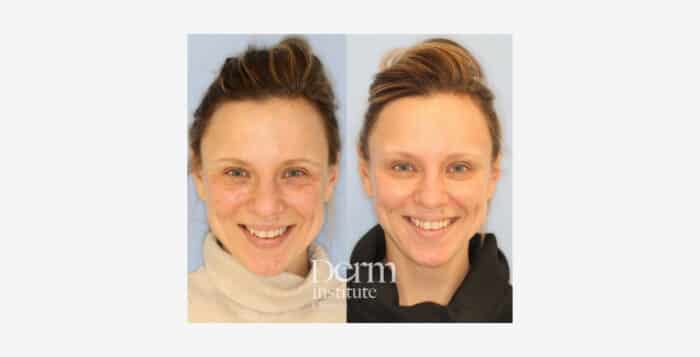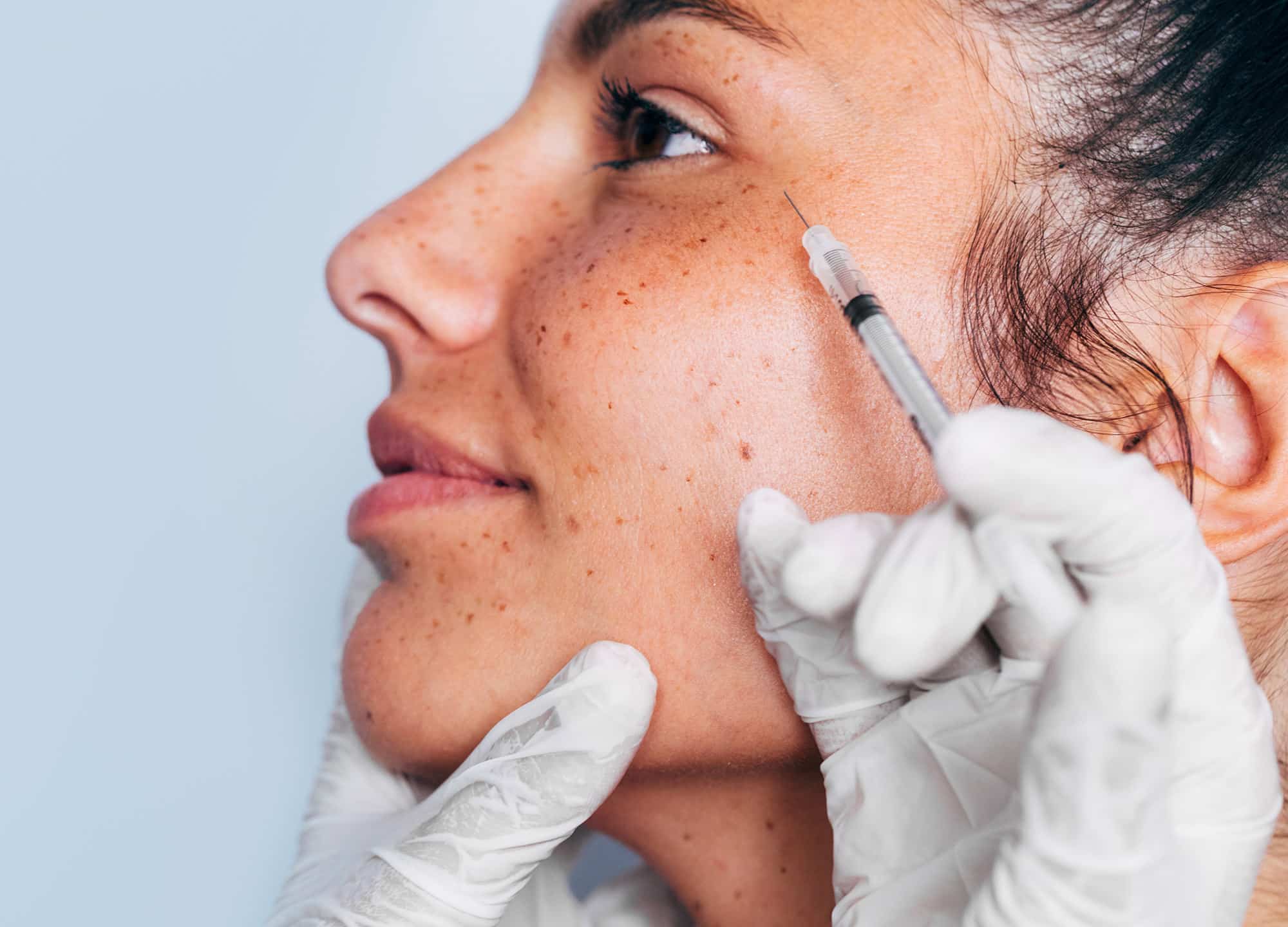I recently turned 34 and, if I do say so myself, haven’t had to deal with any major skin aging issues yet. I credit a combination of good genetics, a diligent sunscreen routine, and yes, the occasional trip to the dermatologist for Botox injections in my forehead. But over the past year, I’ve grown increasingly bothered by more and more fine lines forming under my eyes. They were especially prominent when I smiled; the skin under my eyes would look folded and wrinkly, something that made me extremely self-conscious. I chalked it up to age and upped the ante with my skin-care routine, making a conscious effort to use any anti-aging eye cream I could get my hands on… all of which did absolutely nothing.
A few months ago, I had to send a photo of myself to a doctor, to determine if I was a candidate for a laser treatment. He asked about my primary areas of concern, and I noted the lines around my eyes. Without skipping a beat, he told me that they weren’t age-related but, rather, Dennie-Morgan lines. Erm, what? I’ve been in the beauty industry for 15 years and am familiar with any and every skin condition under the sun—or so I thought. I had never heard of Dennie-Morgan lines.
I immediately booked an appointment with Dr. Jordan Carqueville, a board-certified dermatologist in Chicago (and my long-term personal derm) to get her take—and figure out what we could do about this newly diagnosed issue. Her assessment? Dennie-Morgan lines, indeed. But what exactly are these lines, and how are they different from the typical, age-induced wrinkles?
What are Dennie-Morgan lines?
The big difference between Dennie-Morgan lines vs. normal lines is what causes them. “Dennie-Morgan lines develop after years of chronic allergies or eczema. They form when collagen breaks down due to chronic irritation and inflammation, not from classic intrinsic or extrinsic aging factors,” Dr. Carqueville explains. (FYI, the name comes from an American dermatologist, Charles Clayton Dennie, who defined the condition; the creases are also known as Dennie-Morgan folds or infraorbital folds. They’re also sometimes called Denny Morgan lines.) She adds that they’re most often seen in people with chronic skin conditions (such as eczema or other forms of atopic dermatitis)and allergic rhinitis. People with atopy, a genetic predisposition to developing these types of allergic diseases that’s associated with a hyperactive immune system, are also more at risk of developing these lines, as are those who have generally sensitive skin to begin with (insert hand-raising emoji here). I’ve dealt with occasional eczema flares since childhood, battled perioral dermatitis for a long time in my 20s, and generally have very easily irritated and reactive skin with random rashes galore. It made perfect sense that I would have Dennie-Morgan lines, Dr. Carqueville said. (They also often appear along with allergic shiners, hyperpigmentation or dark circles and puffiness under the lower eyelid caused by chronic inflammation.)
What causes Dennie-Morgan lines to worsen?
While I did feel slightly better knowing that these lines weren’t purely a function of age, I still wanted to figure out what to do about them. No matter the cause, I hated how they looked. When it comes to treating Dennie-Morgan lines, Dr. Carqueville says, the number-one goal is to reduce the underlying cause that’s driving the inflammation and irritation. That includes determining potential environmental and/or ingredient allergens via patch testing (been there, done that); minimizing eye rubbing; and being very careful about the products used around the eyes. To that point, topical or oral antihistamines can help minimize allergy symptoms, alleviating some of the itching, redness, and edema associated with these lines, but they’re not going to address the lines once they’re actually there.
That’s one area where I was doing the complete opposite. Consistently slathering on formulas with tons of active ingredients wasn’t doing me any favors, Dr. Carqueville said. Even if there wasn’t anything in the topical creams that I was technically allergic to, there was a very good chance that applying so many different types of ingredients was triggering some type of inflammation. Her advice regarding topical eye products? “The simpler, the better.” Choose basic hydrating formulas that contain ingredients such as hyaluronic acid and glycerin, both of which are fairly inert and unlikely to cause any irritation (though will help with dry skin, which can exacerbate the look of Dennie-Morgan lines). And if you’re not prone to clogged pores or milia, Vaseline or Aquaphor can be applied around the eyes, simply to lock in hydration, she explains.
What is the best treatment for Dennie-Morgan lines?
If you’ve done all that and still haven’t seen any improvement, there are cosmetic treatments that can help. “To replenish the collagen and volume loss, a combination approach works best,” says Dr. Carqueville. Resurfacing lasers that stimulate collagen (intraocular shields should be worn, to protect the cornea, since they’re being used so close to the eye) can be paired with hyaluronic acid dermal fillers in order to replenish volume and add moisture to the skin, she explains.In severe cases, excess skin and fat can be removed during lower lid blepharoplasty, and this will address Dennie-Morgan lines, too. However, it’s imperative to get medical advice from your healthcare provider or dermatologist, as well as a plastic surgeon, to make sure you’re a good candidate for this procedure. (And, of course, to make sure what you’re dealing with are in fact Dennie-Morgan lines.)
How to get rid of Dennie-Morgan lines

In my case, we decided to start with just hyaluronic acid fillers as a Dennie-Morgan lines treatment; Dr. Carqueville thought I’d get a good result from those alone. She injected half a syringe of Restylane under each eye, using a cannula. As someone who had never had filler in this tear trough area, I was pleasantly surprised by how quick and painless the process was. She also injected a small amount of Dysport under each eye, to help relax the more etched-in lines. Finally, she used six units of Dysport around each eye, to soften some baby crows’-feet. These were different from the Dennie-Morgan lines, but she felt addressing these would help improve the overall appearance of my eye area.
I noticed some improvement instantly—the results from hyaluronic acid filler are pretty immediate—but Dr. Carqueville suggested giving it a full two weeks, for both the Dysport to kick in and any post-filler swelling to subside. It’s now been two and half weeks since my appointment, and I love the result. The change isn’t super-dramatic; I still have lines under my eyes when I smile, but I see a definite improvement. They’re much less prominent and deep, and I feel infinitely more confident—which, at the end of the day, is exactly what I was going for.











